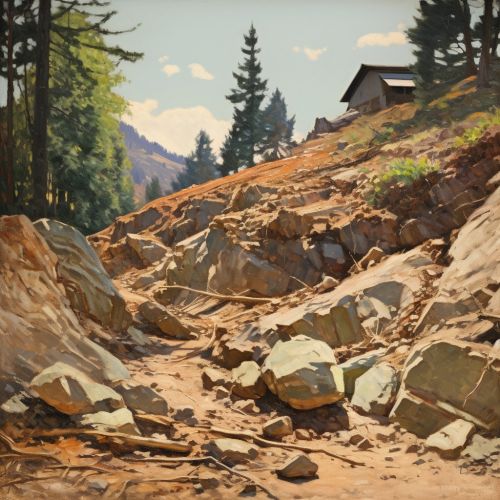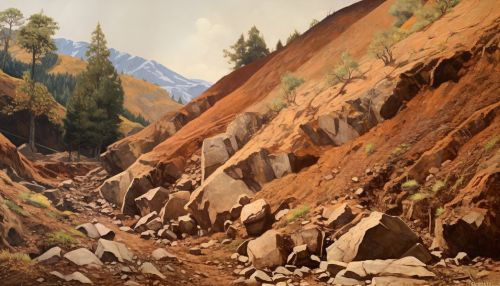Landslide
Introduction
A landslide is a geological phenomenon that involves the movement of rock, earth, or debris down a slope due to gravity. It can occur in offshore, coastal, and onshore environments. Although the action of gravity is the primary driving force for a landslide to occur, there are other contributing factors such as erosion, heavy rain, snowmelt, earthquake or volcanic activity, and changes in groundwater levels.
Types of Landslides
Landslides can be classified into different types based on the type of movement and the type of material involved. The main types of movement include falls, topples, slides, spreads, and flows.
Falls
A fall is a type of landslide where the material moves vertically or near vertically by free-fall, bouncing, or rolling. Rockfalls and debris falls are common examples of this type of movement.
Topples
Topple is a forward rotation out of the slope of a discrete volume of soil or rock around a point or axis below the center of gravity of the displaced mass.
Slides
A slide is a type of landslide that occurs when a layer of soil or rock moves downslope along a clearly defined plane. There are two main types of slides: rotational slides and translational slides.
Spreads
Spread is a type of landslide which occurs on very gentle slopes or flat terrain. The dominant movement is lateral extension accompanied by shear cracks.
Flows
A flow is a type of landslide where the material moves downslope as a viscous fluid. Flows are further classified into five types: debris flows, debris avalanches, earth flows, mudflows, and creep.
Causes of Landslides
Landslides are triggered by natural forces or human activities. Natural forces include the mechanical and chemical weathering of rocks, erosion by rivers and glaciers, and disturbances caused by earthquakes or volcanic activity. Human activities that can trigger landslides include deforestation, excavation, and construction.
Weathering
Weathering is the process of breaking down rocks, soils, and minerals through direct contact with the Earth's atmosphere, waters, or living organisms. It can be a physical or chemical process.
Erosion
Erosion is the process by which soil and rock are removed from the Earth's surface by wind or water flow, and then transported and deposited in other locations. It plays a significant role in the formation of landslides.
Earthquakes
Earthquakes can trigger landslides by shaking the Earth's crust and causing unstable slopes to fail. The shaking can also increase the pore water pressure in slopes, making them more susceptible to failure.
Volcanic Activity
Volcanic activity can trigger landslides by producing loose ash deposits, heavy rain, and debris flows. The steep slopes of volcanoes make them particularly susceptible to landslides.
Human Activities
Human activities such as deforestation, excavation, and construction can increase the likelihood of landslides. Deforestation removes the roots that hold the soil together, making the soil more susceptible to landslides. Excavation and construction can destabilize slopes and increase the risk of landslides.
Effects of Landslides
Landslides can cause significant damage to the environment and human structures. They can block rivers and roads, damage or destroy homes, and lead to loss of life. Landslides can also have long-term effects on the landscape by changing the course of rivers, creating new lakes, and altering the shape of valleys.
Landslide Mitigation
There are several methods for mitigating the risk of landslides, including engineering works, vegetation, and land use policies. Engineering works can include the construction of retaining walls, drainage systems, and slope stabilization. Vegetation can help stabilize slopes by increasing the shear strength of the soil. Land use policies can restrict construction in landslide-prone areas.


